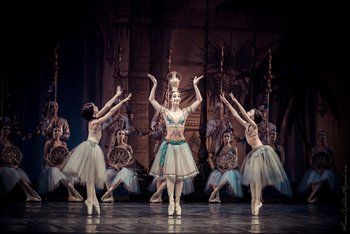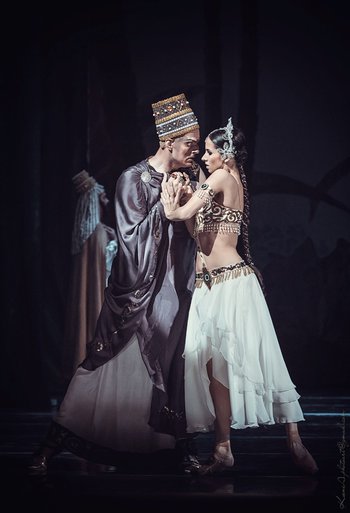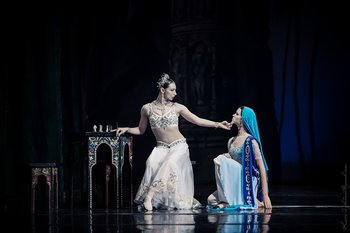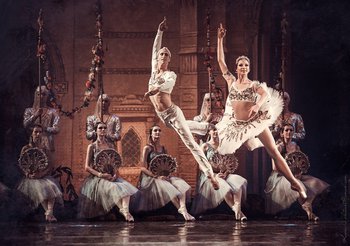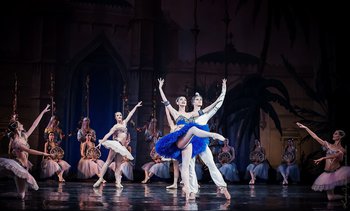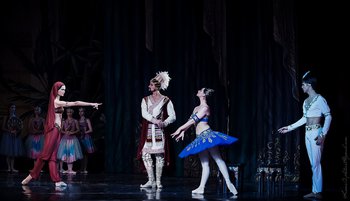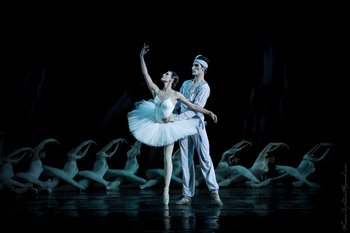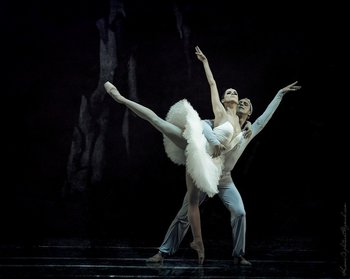Upcoming shows
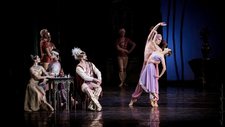
- Costume Designer:
- Iryna PRESS
- Conductors:
- Mykola DIADIURA
- Oleksii BAKLAN
- Rehearsal Coaches:
- Alla LAGODA
- Raisa KHYL’KO
- Concertmasters:
- Oksana GOROBIIEVSKA
- Svitlana TERENTIEVA
- Directors who lead the performance:
- Alla VYSOTSKA
- Oleg TOKAR
"La Bayadere" occupies a special place in the history of Ukrainian choreographic art. It was with this work that the Kyiv ballet founded its history on October 2, 1926. The staging was then carried out by choreographer L. Zhukov, conductor M. Bakaleinikov, and artist M. Levin (according to other sources - S. Evenbakh). The lead roles were performed by M. Reizen (Nikya), L. Zhukov (Solor), A. Gavrilova (Gamzatti), A. Stalinsky (High Brahmin), and A. Berdovsky (Dugmanta).
The ballet “La Bayadere”, first shown in 1877 on the stage of the St. Petersburg Bolshoi Theater, became not only an event of the season, not only one of the best works of Marius Petipa, but also a milestone performance of ballet at that time. "La Bayadere" was called an encyclopedia of dance of the 19th century and combined the creative achievements of not only the St. Petersburg choreographer, but also such outstanding artists as F. Taglioni, Ch. Didelot, J. Perrot, and A. Saint-Leon.
The idea and plot of “La Bayadere” echoed the ballet “Sakuntala” by Ernest Rainer, staged in 1858 on the Parisian stage by Marius's brother, Lucien Petipa. Marius Petipa significantly enriched the plot development, complicated the relationship of the heroes, and gave the image of Nikiya a tragic sound. Critics enthusiastically welcomed the "new, refined, exotic, grand spectacle." And yet, not only the embodiment of the image of Nikiya, but also the scene of "Shadows" remained underestimated. It was believed that the choreographer, "as never before, managed to embody a mass corps de ballet dance, to find its proper place in the performance." But it was from the scene of "Shadows", according to Yuri Slonimsky, that the origins of Lev Ivanov's innovation began, it was in "La Bayadere" that the great dance maestro made an artistic and aesthetic sketch of the future "swan scenes" - the pinnacle of achievement in world ballet art. Together with "Shadows", the poetics of imagery came to the stage, which becomes the dominant dramatic element of the choreographic performance. This already made the premiere of “La Bayadere” by L. Minkus a phenomenon of artistic life, although not fully realized at that time.
The melodramatic plot provided a wide space for an affecting and entertaining performance. But the staging of Marius Petipa required not only great dancing skill, but also the ability to create an image and to show it in its development. It is no coincidence that on January 23, 1877, the performance was danced by the most prominent performers of the time: K. Vazem (Nikiya), L. Ivanov (Solor), M. Goltz (The High Brahmin), H. Johansson (Dugmanta), and M. Gorshkova (Gamzatti).
Subsequent interpretations significantly changed the choreographic score of Marius Petipa, and adjustments were made through time. The accumulation of secondary exotic dances disappeared; the structure of the performance became more accurate and harmonious. But all the best from the first production survived and found its stage embodiment in the production of V. Chabukiani and V. Ponomarev, which later formed the basis of the Kyiv production of Valerii Kovtun, which premiered on June 27, 1985 and with a short break (the choreographer Natalia Makarova had a production on the Kyiv stage, the premiere was on February 14, 2013, and the conductor was Mykola Diadiura) has not left the stage since then. Conductor Allin Vlasenko, artists Vyacheslav Okunev and Irina Press worked together with V. Kovtun at the time.
The lead roles in Kyiv productions were performed by prominent Ukrainian dancers - R. Khilko, T. Tayakina, L. Smorgachova, G. Kushnerova, T. Borovik, O. Filipieva, T. Beletska, G. Dorosh (Nikiya); T. Tayakina, L. Smorgachova, T. Litvinova, T. Borovik, L. Danchenko, N. Khomenko, I. Dvorovenko, T. Golyakova, O. Filipieva, (Gamzatti); V. Kovtun, M. Pryadchenko, S. Lukin, V. Yaremenko, V. Vidineev, K. Kostyukov, S. Kravets, M. Motkov, G. Zhalo, D. Matvienko, A. Datsishin, S. Sidorsky (Solor); V. Litvinov, V. Rybiy, D. Klyavin, S. Serkov, O. Tokar (High Brahmin).



